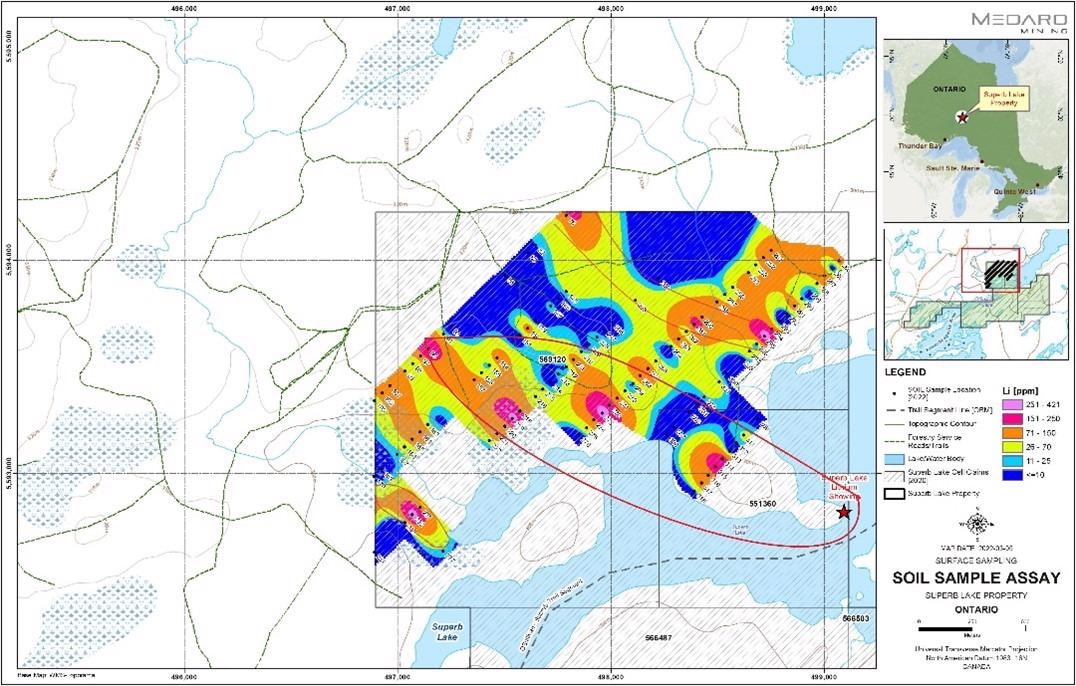Medaro Mining Corp., a versatile mineral explorer and joint venture (JV) partner with Global Lithium Extraction Technologies Inc. reported that soil sampling results from their Phase 1 exploration fieldwork program (“Program”) on its Superb Lake Lithium Property (“Property”) in Northwestern Ontario, Canada, have been received.
 Superb Lake 2021 soil sampling map with contoured lithium assay results is available. Image Credit: Medaro Mining Corp.
Superb Lake 2021 soil sampling map with contoured lithium assay results is available. Image Credit: Medaro Mining Corp.
The findings reveal a northwest-southeast trend of lithium anomalies along Superb Lake pegmatites, as well as two additional anomalies to the north and south of the main trend. Past results from four samples collected in 2020 from a spodumene-rich section of the Superb Lake pegmatite showed lithium oxide (Li2O) values ranging from 1.77–4.03%, and results from channel sampling in 2021 reveals 1.15% Li2O over 5.8 m.
Program Highlights
- The pegmatite Superb Lake is known primarily for its spodumene-bearing lithium mineralization. The exploration work in 2021 included soil and rock channel sampling as well as geological mapping, intending to define the extent of lithium mineralization along the strike of the recognized pegmatite and identify new target areas for future exploration.
- Soil sampling results reveal a main northwest–southeast trending soil anomaly in the Superb Lake lithium pegmatite extension, with lithium values ranging from less than 10 parts per million (ppm) to 310 ppm over a strike length of 1250 m.
- The other two lithium anomalies lie to the north (109 ppm and 311 ppm over two lines) and south (up to 311 ppm) of the major lithium trend.
- These anomalies suggest that more pegmatites may be discovered in the area as a result of additional soil sampling, trenching and sampling programs.
Sampling and Analytical Procedure
Soil samples were collected after establishing soil grids of six lines at approximately 250 m line spacing and collecting a total of 319 soil samples. Using a SciAps Z-300 laser-induced breakdown spectroscopy (LIBS), elemental analysis was carried out on the samples. When a B- soil horizon was present, soil samples were collected at predetermined station IDs using a Garmin GPS to acquire a 3 m accuracy and >500 g of material were selected.
Before being analyzed at room temperature, the soil samples were dried in cotton bags for two weeks. The B-horizon soil layers were chosen for analysis, and humus samples were initially rejected but saved for future use.
The dried soil from each sample ID was then sieved to produce a final homogeneous 50 gm sample of the material with a grain size of less than 2 mm. The 50 g sample was mixed in a new sample bag, and ~7 g of material was introduced to a stainless-steel dish and compressed with a 5-ton hydraulic press to produce a solid pellet, from which a composite of five readings was taken, each taking 3 seconds, for a total reading time of ~15 seconds.
With a detection limit of 5 ppm, the final reported concentration is the average of the five readings.
For elemental analysis, the samples were examined using a SciAps Z-300 laser-induced breakdown spectroscopy (LIBS) system. When compared to air-based analysis, the Z-300 platform has OPTi-PurgeTM incorporated, user-replaceable argon purge technology for enhanced precision on all elemental lines.
Class 3b laser source (1064 nm, 3–6 mJ) with 50 μm beam diameter and 50 Hz operation, as well as rapid sample cleaning to eliminate the need to grind or clean sample surfaces. Subject to local LSO approval, the internal sample presence sensor allows the device to operate in Class 1 conditions.
A high-resolution spectrometer with a spectral range of 190–420 nm is also included in the Z-300. Operators can easily view tests thanks to the integrated camera, which ensures good burns for curved or small pieces.
A macro camera is also included, which takes photos of the materials being tested as well as reading barcodes and QR codes. For testing wires, inclusions or material veins, settable one-dimensional beam rastering is used.
With battery, it weighs only 3.9 pounds and has a 2.7" high-brightness rear-facing display for simple results viewing. The Android operating system, which is Google-powered and apps-based, provides smartphone-level simplicity and intuitive operation. Wireless, GPS and Bluetooth are all built-in for easy device connectivity.